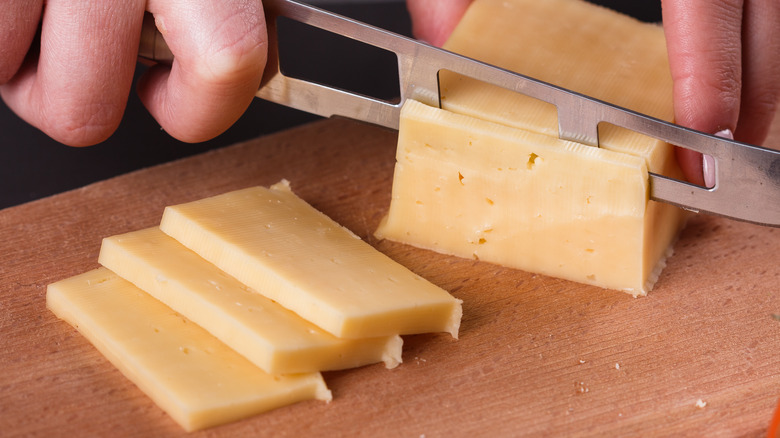The Fridge Mistake You Need To Stop Making With Your Cheese
From Instagram-worthy charcuterie boards to late-night cracker stacks, we'd be in a real snack lurch without cheese. Thankfully, most of us usually always have some type of cheese on hand. In fact, an informal poll on Reddit found that most cheese lovers tend to keep at least five to seven different types in their fridge at any given time. There's a common mistake, however, when it comes to refrigerating cheese. Namely, you should always let aged cheese like cheddar warm up before you eat it, but don't keep taking it out of the fridge and putting it back in over and over.
Cheese is a very temperature-sensitive product on a couple of different levels. First, you have to keep food safety in mind because bacteria that can make you sick can grow in just a couple of hours. From a quality standpoint, cheese will degrade in a short amount of time, and putting it back in the refrigerator won't save it. To keep it in good condition, only take out enough cheese to eat and leave the rest since constant temperature changes are bad for the texture.
Aged cheese should be served at room temperature
Despite the fact that cheese is sold and stored cold, it's actually not supposed to be served that way. Aged cheese can taste flavorless and have a dry, crumbly, or rubbery texture when it's chilled. It's when you take it out of the fridge and let it warm up to room temperature — or around 68–72 degrees Fahrenheit — that the fat in the cheese softens and releases the flavors. This rule doesn't necessarily apply to soft cheeses, like ricotta or cream cheese, but in the case of most aged cheeses, like brie, cheddar, and parmesan, you can really taste nuances (like cheddar's irresistible sharpness) when the cheese is served at the right temperature.
With that said, there's a limit to how long cheese can sit out. If you've ever arrived late to a party only to find a picked-over pile of congealed cheddar on the snack table, you know that letting cheese linger too long outside of the refrigerator will cause it to degrade. You'll want to grab only the amount of cheese you want to eat or serve, and avoid taking it in and out of the refrigerator. If you're in party-planning mode and want some pre-cut cheese for guests to snack on, do that prep just before serving since cheese can dry out quickly. If your guests aren't eating it fast enough, an easy trick is to eat a few pieces yourself so it doesn't look picture perfect.
Food safety is also critical
Besides the heartbreak of ruining an expensive chunk of aged cheddar by leaving it out on the counter, temperature can also be a health hazard. Cheese is made with milk, which is a perishable product that can go bad quickly and harbor foodborne bacteria that can make you sick, depending on how much moisture there is in the cheese. Fresh cheeses, like ricotta, mozzarella, and chèvre, for example, should be refrigerated after two hours. Harder cheeses, like cheddar and gouda, can stay out for around four hours. Truly hard cheese, like aged Parmigiano-Reggiano and Romano, will last the longest outside of the fridge because they have very low moisture. In fact, they don't actually need refrigeration for safety, but they'll last a lot longer in cold storage.
With all that in mind, it's also pretty easy to notice when a cheese board has gone around the corner. Keep an eye on the time if you're entertaining a crowd with fresh cheese, and look for signs of spoilage like a slimy, oily surface, discoloration, dryness, and cracking. If any of the cheese is starting to look a little tired, chances are it's time to toss it. As for the stuff in the fridge? Keep it in the vegetable crisper so it's always fresh for next time.


